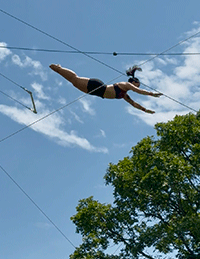Varigate Porphyria (VP)

Melissa “Missy” Nagin: Flying High — Living Boldly with Variegate Porphyria
“I proved to myself that even though I have a rare genetic condition, with some extra preparation, lots of sunscreen, sun-protective clothing, and snacks — nothing can stop me. Anything is possible.”
- Missy Nagin
Melissa "Missy" Nagin was a healthy young woman. However, when she went to college, she began drinking alcohol and taking birth control — all of which contributed to the beginning of strange symptoms.
No one could diagnose her pain, skin symptoms, and general misery. This went on for a long time until she saw a dermatologist whose first practice was hematology — Dr. Lydia Evans. Dr. Evans made the overall diagnosis of porphyria and knew what tests to send to confirm this diagnosis. She recommended that Missy see Dr. David Bickers and Dr. Maureen Po, who are porphyria experts. They made the official diagnosis of Variegate Porphyria.
She graduated from nursing school and moved to St. Louis to start her career as a bone marrow transplant nurse. It was here that she had her first acute porphyria attack. Despite having a confirmed diagnosis of Variegate Porphyria and ER guidelines from the Porphyria Foundation, her care was mismanaged in the hospital, and her porphyria was not treated until about 10 days into her stay. The porphyria symptoms continued to get worse as she was not being treated. Finally, Panhematin was administered, and her symptoms began to subside slowly.
The diagnosis did not stop the attacks. She also made another life-changing decision to move to Seattle, Washington. Fred Hutchinson Cancer Research Center had a porphyria expert working there, and Missy needed to be somewhere where they knew what to do when she got sick.
After the big move across the country, a good friend from nursing school invited her to SANCA, the School of Acrobatics and New Circus Arts. Having never visited a circus school, she went with the friend — and was immediately hooked. She began learning the flying trapeze! When she was well and not working, she joined classes and practiced trapeze as well as other circus disciplines. She loved getting to move her body and gain strength at the same time. When she was ill, she strived to get well so she could have fun on the trapeze. It became her life outside of work.
She now teaches and performs at SANCA and Emerald City Trapeze Arts, and her porphyria expert understands and adjusts her treatments when needed to help maintain her work/life balance.
Missy vowed to not let porphyria rule her life and sees herself as uniquely special. Her friends describe her as full of life, caring, and having a kid-like energy that is frequently contagious.
She has a passion for world travel and wants to go everywhere and see everything. Recently, she returned from a trip to India for two weeks. She has traveled around the world, including summiting Mt. Kilimanjaro and volunteering in Cambodia — taking care to follow all the porphyria rules about rest, diet, no alcohol, and no unsafe drugs.
She is also fortunate to have a porphyria expert adjust her medications, because she continues to have attacks. At present, she is taking Givlaari to prevent or reduce attacks and Panhematin to stop the breakthrough attacks she experiences.
Interestingly, her prodrome is a haze in the left eye that frequently progresses to a complete blackout. When that happens, she knows an attack is coming and heads to the ER to have the Panhematin infusion to stop the attacks fast. For more information on why it’s important to ACT FAST! Click hereHer expert has a treatment plan in place at the ER, which even includes that she knows the attack is coming when her left eye gets hazy.
The ER sometimes pays attention and administers the Panhematin, but frequently requires either Missy or a friend to advocate for her. Stopping the attack fast is key to getting well fast and keeping nerve damage at bay.
Her decision to move near a porphyria center was a good one.
Kilimanjaro: Reaching New Heights

At 29 years old, Missy traveled to Tanzania with four others from the U.S. to conquer the tallest peak in Africa. Their journey up the Lemosho Route took eight days, supported by experienced guides and 25 porters.
“Pole pole” — Swahili for “slowly slowly” — became their mantra as they adjusted to the altitude and pushed forward step by step.
They hiked through lush forests and rocky terrain, battled fatigue, headaches, and sleepless nights. One particularly rough night at Lava Tower (15,000+ feet) left everyone depleted, but Missy pressed on.
At Barafu Base Camp (15,019 ft), she lay in her tent knowing the summit attempt would begin at midnight. Bundled in layers, headlamps on, they hiked into the darkness — hundreds of climbers all chasing the same goal.
“I started counting steps just to keep my mind busy,” Missy recalls.
After nearly 9 hours of climbing in the dark, the sun rose and illuminated the final stretch. With frozen fingers and a pounding heart, Missy reached Uhuru Peak — 19,341 feet above sea level.
She had done it. A woman with a rare, misunderstood disease had just stood on top of the world.
The journey down was dizzying and exhausting. But with each step, the magnitude of her achievement became clearer.
“I proved to myself that even though I have a rare genetic condition, with some extra preparation, lots of sunscreen, sun-protective clothing, and snacks — nothing can stop me. Anything is possible.”
Missy will be an upcoming guest on our APF podcast RARELY DISCUSSED, where she’ll share more of her journey in her own words.
?? Watch her upcoming episode — and many other inspiring patient and caregiver stories and porphyria experts sharing their knowledge: https://www.youtube.com/@RarelyDiscussedpodcast/featured


